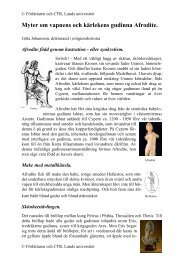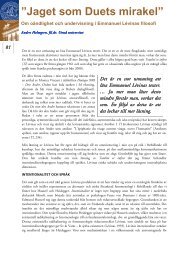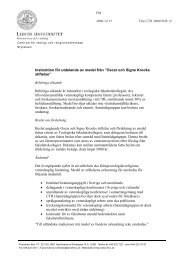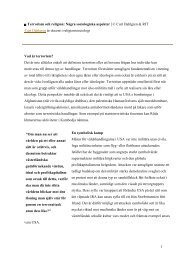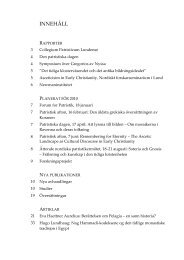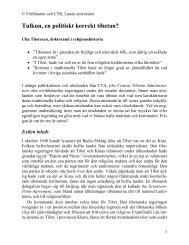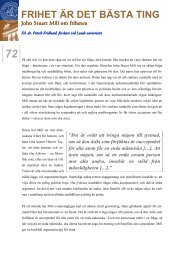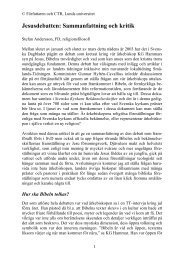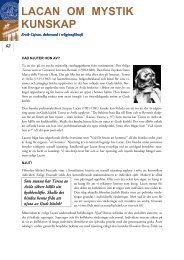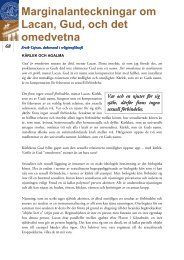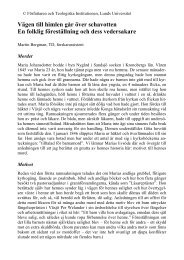Meddelanden 25 (2010) (PDF 2.0 MB - Nytt fönster) - Centrum för ...
Meddelanden 25 (2010) (PDF 2.0 MB - Nytt fönster) - Centrum för ...
Meddelanden 25 (2010) (PDF 2.0 MB - Nytt fönster) - Centrum för ...
You also want an ePaper? Increase the reach of your titles
YUMPU automatically turns print PDFs into web optimized ePapers that Google loves.
philosophers, Origenist monks, and Melitians; I have noted elsewhere that the<br />
closest parallels to the monastic cartonnage from the Nag Hammadi codices<br />
are found among Melitian documents. 26 While the literary nature of these<br />
references must be taken into account, the picture of a diverse environment,<br />
albeit one confronted by the Pachomians, makes sense in light of the Nag<br />
Hammadi evidence. If the Pachomians did not produce or own these texts,<br />
other ascetically minded persons, who may well have lived as monks, did.<br />
How little we actually know of the area was underscored for me already as a<br />
graduate student when, during the 1977–78 archeological season at Faw Qibli<br />
(Pbow), the unrelated excavation of a new irrigation ditch by local authorities<br />
some 750 meters north of the site of the Pachomian basilica began to unearth<br />
large quantities of early Roman ware and cut through the remains of a<br />
sizeable limestone wall. 27 We have in fact no idea what it was. One can only<br />
imagine what else existed in the area of which we haven’t a clue.<br />
When the question of a specific provenance is left behind, new<br />
approaches begin to emerge. In his article on “The Successors of Pachomius<br />
and the Nag Hammadi Codices,” for example, Philip Rousseau, building on<br />
Michael Williams’ work, suggests that the “habit of analysis that seems to<br />
have governed the compilation of each codex” finds parallels in the writings<br />
of Pachomius’ successors. 28 Comparing the various sources, he observes:<br />
The conclusions drawn from a reading of the Bible and from observation of the world<br />
of experience were different; but the habit of thinking, of exercising curiosity, was<br />
closely connected. The identification of ancient figures of wisdom, leading through a<br />
sense of New Testament fulfillment, or at least corroboration, and through a series of<br />
exhortatory reflections, and culminating in a vision of the future: that describes very<br />
closely the flow, if not the content, of Theodore’s and Horsiesios’s teaching. Within<br />
some of the surviving Nag Hammadi codices, there is a similar curve of logic, carrying<br />
an ascetic from the warnings and promises of the prophets into the transformation of<br />
his own heart and body. 29<br />
He continues, a short time later:<br />
That suggests in turn that people who thought like Theodore and Horsiesios would<br />
have found the Nag Hammadi codices useful, once the originally “gnostic” material<br />
had been rearranged—“recycled”—according to new patterns. We do not have to<br />
26 Goehring, “The Provenance of the Nag Hammadi Codices once more,” 246–50.<br />
27 Van Elderen, “ The Nag Hammadi Excavations,” 230–31; Goehring, “New Frontiers in<br />
Pachomian Studies,” <strong>25</strong>6; reprinted in Ascetics, Society, and the Desert, 182.<br />
28 Philip Rousseau, “The Successors of Pachomius and the Nag Hammadi Codices: Exegetical<br />
Themes and Literary Structures,” in The World of Early Egyptian Christianity: Langauage,<br />
Literature, and Social Context, Essay in Honor of David W. Johnson (Washington, D.C.: The<br />
Catholic University of America Press, 2007, 140–57 (quotation, page 141); Michael Allen<br />
Williams, Rethinking “Gnosticism”: An Argument for Dismantling a Dubious Category<br />
(Princeton: Princeton University Press, 1996), especially ch. 11 (233–62).<br />
29 Rousseau, “The Successors of Pachomius,” 156–57.<br />
∙ 68 ∙



